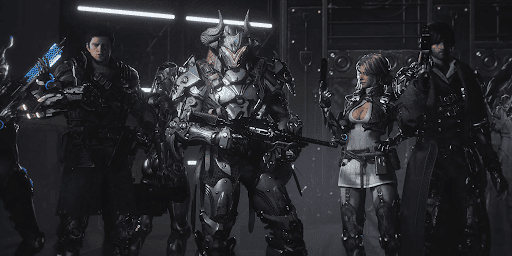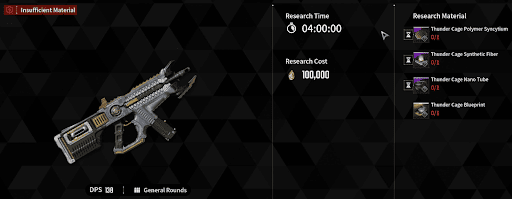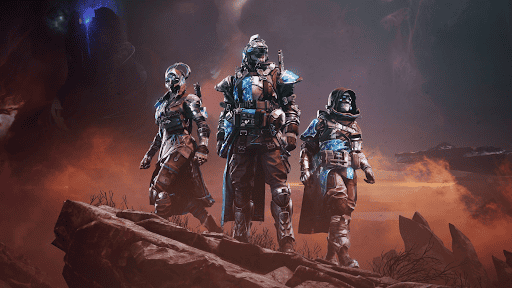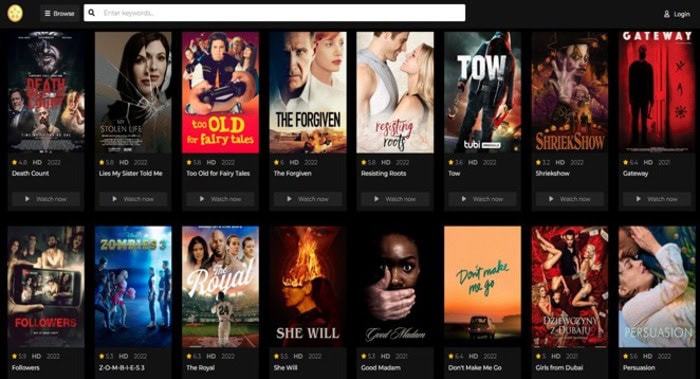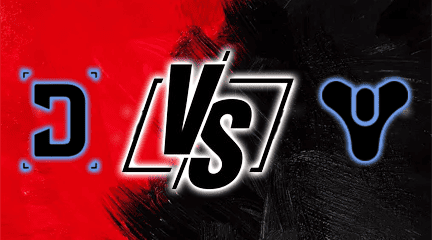
Introduction
Whenever a new game grabs our attention, we naturally compare it to existing titles. It goes the same when talking about Looter-Shooters. In this article, we’ll delve into The First Descendant and Destiny 2, highlighting their distinctions and commonalities, such as their class systems, crafting, end-game activities, and more.
Our guide for The First Descendant vs Destiny 2 is designed with user-friendliness in mind, making it simple to follow and navigate.
Let’s begin our exploration of these two games, starting with the campaign.
The First Descendant vs Destiny2 Campaign
The campaign in The First Descendant (TFD) is quite straightforward. Currently, players can explore three districts, each divided into three to five zones. In these zones, you’ll find three to four missions that drive the storyline forward. Your primary objective is to defeat Karel, the new leader of Vulgus.
In contrast, Destiny 2’s campaign is more impressive, detailed, and content-rich. Additionally, thanks to the annual expansions, the story continually expands with the introduction of new NPCs and enemies, making it even more engaging.
Completing a build and various in-game activities can demand advanced game knowledge and many hours of grinding the same content. Fortunately, Kboosting.com provides boosting services for both The First Descendant and Destiny 2 to assist you in achieving your goals, whether it’s completing your builds, conquering end-game activities, unlocking weapons and perks, or tackling the most challenging content in these games.
Moving on, let’s see on which platforms you can play these games.
The First Descendant vs Destiny 2 Platforms
Both games are available on multiple platforms, catering to a broad player base, including PC, PlayStation 5, Xbox Series X, and Series S. Destiny 2 holds a slight advantage by also offering support for PlayStation 4 and Xbox One consoles, ensuring a wider reach and accessibility across a range of gaming systems.
Now, let’s briefly examine the class systems in both games.
The First Descendant vs Destiny 2 Class System
In this category, Destiny 2 falls short compared to The First Descendant, which offers a wider variety of class types, unique abilities, and diverse playstyles. Let’s take a closer look at these class systems.
TFD Classes
In The First Descendant (TFD), there are 11 descendants, starting with Lepic, Ajax, Viessa, Jayber Sharen, Gley, Blair, Bunny, Freyna, Valby, and Kyle. Each class has distinct roles like debuffer, tank, AoE dealer, and more. Each descendant has four primary skills and a passive ability. Moreover, some of these skills can be influenced by the Module system.
D2 Classes
In terms of the class system, Destiny 2 adopts a more straightforward approach, offering the three iconic classes: Hunter, Titan, and Warlock. Each of these classes provides players with five subclasses associated with different elements like Solar, Arc, Void, Stasis, and Strand, determining the corresponding damage type.
Let’s explore the gear system for both games.
The First Descendant vs Destiny 2 Gear
Both titles feature a complicated system when talking about gear. The First Descendant features weapons with Modules like Warframe, where you can enhance your weapon and create various combinations, and for Destiny 2, you have Perks that can allow certain weapons to shine in special activities like PvE and PvP.
TFD Gear & Modules System
In The First Descendant, you have a wide array of weapon types at your disposal, ranging from Rifles and Shotguns to Snipers and SMGs, among others. Players can simultaneously carry three weapons, a reactor, and four external components, allowing for diverse loadout customization and gameplay options.
The Weapon Module system in The First Descendant bears a striking resemblance to the one found in Warframe. It allows players to enhance various weapon attributes like fire rate, accuracy, firearm attack, and other statistics, considering they have sufficient module capacity cost to do so. This system adds an element of customization and strategy to fine-tune your equipment and suit your playstyle.
D2 Gear & Perks System
Destiny 2 features an extensive range of weapon types compared to TFD, with the additional distinction of three types of ammunition. Primary ammo weapons include Auto Rifles, Pulse Rifles, and various others. Special ammo weapons encompass Fusion Rifles, Shotguns, and more. Finally, heavy ammo weapons consist of Swords, Rocket Launchers, and numerous other options, providing a diverse selection for players to choose from in each ammunition category.
The Perk system offers special abilities that can be attached to weapons and armor to enhance their performance. That’s not so simple, as some perks are good only for the PvE content and others for the PvP activities. The total number of perks that you can equip varies based on the tier and type of the item.
Next, let’s take a quick look at the crafting system for both titles.
Crafting in The First Descendant vs Destiny 2
Both TFD and D2 have their crafting systems. The more robust crafting system is found in Destiny 2, offering various enhancements like improving perks, increasing weapon levels, shaping and reshaping weapons, and more. TFD, on the other hand, is more user-friendly when it comes to crafting, allowing players to create descendants and ultimate weapons. The choice between the two depends on your preference for complexity or simplicity in crafting.
TFD Crafting
Crafting in The First Descendant is quite user-friendly. At the Research Institute, you can craft materials needed to unlock various weapon types and descendants. Additionally, the Weapon Level Transmission allows you to transfer a weapon’s level to your ultimate one, eliminating the need to grind for maximum levels. This system simplifies the process and enhances the overall crafting experience.
Crafting in Destiny2
In contrast, the crafting system in Destiny 2 is more intricate and involved compared to TFD. Weapons here also feature a weapon’s barrel, magazine perks, two main perks, and a Masterwork bonus. Not all weapons can be crafted in the game. In general, you can craft seasonal weapons, raid weapons, and expansion-related weapons, but some dungeon gear and PvP activities do not offer craftable weapons.
Now, let’s delve into one of the most exciting aspects of these games: the end-game content.
The First Descendant vs Destiny 2 End-game
Destiny 2 is undeniably a prominent leader in this category due to its longer history, providing players with an abundance of content, including Dungeons, Raids, Nightfalls, Lost Sectors, and various Seasonal activities. The First Descendant, being relatively new, is still in its early stages, including only Void Interceptions and Operations. But there’s hope that we’ll see the introduction of similar or perhaps unique activities in the near future.
TFD End-game
● Operations – Consists of six operations scattered around the world of The First Descendant. In every district, you’ll find a Mine Blocking operation that consists of capturing the A, B, C, D, and E zones. Another activity found in every district is Resource Defense, a wave-style mission where you have to defend your Kuiper from the monsters and bosses. Both operations missions will offer Amorphous Material upon successfully completing or retreating when the game gives you the chance.
● Void Interceptions – Are boss battles that require players to focus on specific bosses to gain access to their Amorphous Material contents. These encounters offer dynamic challenges, featuring destructible parts, varying resistances, and utilizing distinctive, powerful attacks, thus demanding a high level of skill and strategic prowess in every engagement. Also, these interceptions come with two difficulties, featuring the Normal and Hard difficulty containing unique bosses and mechanics.
D2 End-game
● Dungeons – Are 3-player activities with fewer mechanics than Raids but still challenging. They come in Normal and Master difficulty, with Master having the same mechanics but higher combat difficulty. Also, the Master difficulty offers a special Artifice Armor with high stats and a special mod slot that gives 3 extra points to a stat of your choice without any downside.
● Raids – Are 6-player activities that rely on team coordination and mechanic mastery. Also, they feature a Normal and Master difficulty, where the combat is significantly harder. For the reward, we have high-stat focused armor and Adept weapons (versions of the same weapon with extra Perk options, extra mod options, and higher stats). You can expect time limits, call-outs, Boss DPS checks, and wipes when you do a mechanic incorrectly.
● Nightfalls – These are Strikes but more challenging. They are available in Hero, Legend, Master, and Grandmaster difficulty levels, with Grandmaster being the toughest and most rewarding. Grandmaster Strikes come with punishing modifiers like restarting the entire Strike upon a team wipe, no revive timer, and others. The rewards include Vanguard reputation and gear, weekly rotating Nightfall weapons (Adept at GM difficulty), as well as upgrade materials like Prism, Shards, and Exotic Armor.
A long list, but we covered the most important activities. Now, let’s focus on the Pros and Cons of these games.
Pros & Cons of The First Descendant and Destiny 2
When comparing two games, they often excel in some aspects while falling short in others. Let’s delve into some of the most frequently asked questions about TFD and D2, starting with:
Which game should you play?
If you’re a fan of looter shooters, it’s worth giving both games a try, as they are labeled as “free-to-play.” These titles offer distinct experiences, with one still in its early stages, promising more content in the future and presenting a less challenging experience. The other, on the other hand, offers a wide range of content that demands a skilled team and advanced knowledge, but it can be more complex for beginners.
Which game is easier?
The First Descendant is way easier than Destiny 2 in every case. The crafting system is very straightforward, only composed of unlocking Ultimate Weapons and Descendants. You don’t have Raids or Dungeons that require coordination and mechanic knowledge (not yet), so in total, the game is targeting a casual audience.
Are these games free to play?
Yes, both games are free to play, but there’s a catch. In the case of The First Descendant, we currently lack information about the microtransaction system, so it’s important to be aware that the game may potentially include some pay-to-win elements. However, this can vary and may become clearer as time goes on.
When discussing Destiny 2, it’s important to note that the game is labeled as “free-to-play,” but there are limitations. To access special activities such as Dungeons, Raids, Trials of Osiris, Nightfalls, and some gear, the players need to purchase expansions. The cumulative cost of these expansions can amount to around $200, excluding the annual pass.
Now that we’ve covered all the topics let’s proceed to our final conclusion.
Conclusion
In this guide, we’ve discussed the key features of The First Descendant and Destiny 2, explored their similarities, and considered which one might be the right choice for you. Based on our experience, both games offer enjoyable activities and are worth your time. You have the option to play either one or both, depending on your preferences.
